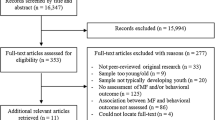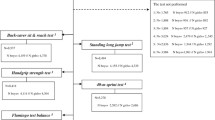Abstract
Objectives
The aim of the ‘Motorik-Modul’ (MoMo Basiserhebung, www.motorik-modul.de) was to establish prevalence measurements on physical fitness and physical activity in German children and adolescents and to identify differences between age groups and genders. A total of 4,529 children and adolescents between the ages of 4–17 years from 167 cities across all states of the German Federation participated in this study. Sociodemographic parameters were recorded. Physical fitness was measured using endurance, strength, coordination and flexibility tests. Physical activity was assessed using a validated questionnaire, including aspects of physical activity participation (school/club/non-club), intensity of physical activity and type of activity. Chi-square tests and ANOVAS were used to compare groups and to detect age and gender effects, and data were compared with criterion-related guidelines by the WHO. For parameters describing physical fitness, age was the dominant influencing parameter. Many parameters showed increasing performance until the onset of puberty. Boys generally performed better than girls except in fine motor coordination during precision tasks and in flexibility. Physical activity was greater in older subjects with a greater intensity for adolescents who were physically active. The general activity level was similar to the data reported in the HBSC study by the WHO but lower than the recommended activity levels.
Conclusion
With the results of this study, nationwide representative prevalence data on physical fitness and physical activity are available. These data contribute to the scientific knowledge on the prevalence and conditions of physical fitness and physical activity.










Similar content being viewed by others
References
American Alliance for Health PEaRA (eds) (1965) Youth fitness test. Manual. American Alliance for Health, Physical Education and Recreation, Washington, DC
Andersen LB, Harro M, Sardinha LB et al (2006) Physical activity and clustered cardiovascular risk in children: a cross-sectional study (The European Youth Heart Study). Lancet 368:299–304
Araujo CG (2008) Flexibility assessment: normative values for flexitest from 5 to 91 years of age. Arq Bras Cardiol 90:257–263
Beck J, Bös K (1995) Normwerte motorischer Leistungsfähigkeit. Sport und Buch Strauss, Köln
Beunen G (1982) The Leuven Growth Study of Flemish Girls: study design and data quality control. In: Simons J, Renson R (eds) Evaluation of motor fitness. Report of the European research seminar on the evaluation of motor fitness. Institut of Physical Education, Leuven, pp 59–76
Borraccino A, Lemma P, Iannotti RJ et al (2009) Socioeconomic effects on meeting physical activity guidelines: comparisons among 32 countries. Med Sci Sports Exerc 41:749–756
Bös K, Heel J, Romahn N et al (2002) Untersuchung zur Motorik im Rahmen des Kinder- und Gesundheitssurveys [Examination of motor fitness within the scope of The Child and Adolescent Health Survey]. Gesundheitswesen 64(Suppl 1):S80–S87
Bös K, Opper E, Woll A (2002) Fitness in der Grundschule. Förderung von körperlich-sportlicher Aktivität, Haltung und Fitness zum Zwecke der Gesundheitsförderung und Unfallverhütung. Bundesarbeitsgemeinschaft für Haltungs- und Bewegungsförderung, Wiesbaden
Brettschneider W-D (2005) Die SPRINT-Studie Eine Untersuchung zur Situation des Schulsports in Deutschland. Meyer & Meyer, Aachen
Breuer C, Wicker P (2008) Sportvereine in Deutschland. Sportentwicklungsbericht 2007/2008. Analyse der Situation der Sportvereine in Deutschland. Deutsche Sporthochschule Köln, Cologne
Corbin CB, Pangrazi RP, Welk GJ (1998) Physical activity for children. A statement of guidelines. Council for Physical Education for Children (COPEC) of the National Association for Sport and Physical Education an association of the American Alliance for Health, Physical Education, Recreation and Dance
Davis KL, Roberts T, Smith RR et al (1994) North Carolina Children and Youth Fitness Study. Am J Health Educ 65:65–72
Deutsche Shell Holding GmBH (2002) Jugend 2002. 14. Shell Jugendstudie. Fischer, Frankfurt am Main
Eurofit (1993) Eurofit Tests of Physical Fitness. Strasbourg
Fares M (1982) Physical Fitness und sportmotorische Geschicklichkeit bei 11-14jährigen deutschen und ägyptischen Schülern. Ph.D. dissertation. Universität Heidelberg, Heidelberg
Fleishman EA (1964) The structure and measurement of physical fitness. Prentice Hall, New York
Fuchs R (1989) Sportliche Aktivitaet bei Jugendlichen. Entwiclungsverlauf und sozial-kognitive Determinanten [Sport activity in adolescents. Development and socio-cognitive determinants]. bps, Köln
Fuchs R, Göhner W, Seelig H (2007) Aufbau eines körperlich-aktiven Lebensstils. Theorie, Empirie und Praxis. Hogrefe, Göttingen
Fuchs R, Semmer N, Lang P et al (1987) Körperliche Aktivität von Jugendlichen. Validität der Messung, Prävalenz und Determinanten. In: Laaser U, Sassen G, Murza G et al (eds) Prävention und Gesundheitserziehung. Berlin, Springer, pp 245–256
Gogoll A, Kurz D, Menze-Sonneck A (2003) Sportengagements Jugendlicher in Westdeutschland. In: Schmidt W, Hartmann-Tews I, Brettschneider W-D (eds) Erster Deutscher Kinder- und Jugendsportbericht. Hofmann, Schorndorf, pp 145–165
Green LN, Williams K (1992) Differences in developmental movement patterns used by active versus sedentary middle-aged adults coming from a supine position to erect stance. Phys Ther 72:560–568
Holm I, Fredriksen P, Fosdahl M et al (2008) A normative sample of isotonic and isokinetic muscle strength measurements in children 7 to 12 years of age. Acta Paediatr 97:602–607
Kirsch A (1968) Standard fitness test. Lehrhilfen Leibeserzieh 17:133–140
Klaes L, Rommel A, Cosler D et al (2000) Bewegungsstatus von Kindern und Jugendlichen in Deutschland. Kurzfassung einer Untersuchung im Auftrag des Deutschen Sportbundes und der AOK- Die Gesundheitskasse. WIAD-Studie, Bonn
Knuth AG, Hallal PC (2009) Temporal trends in physical activity: a systematic review. J Phys Act Health 6:548–559
Kraus H, Hirschland RP (1954) Minimum muscular fitness tests in school children. Res Q Exerc Sport 25:178–188
Kurth BM, Kamtsiuris P, Holling H et al (2008) The challenge of comprehensively mapping children's health in a nation-wide health survey: design of the German KiGGS-Study. BMC Public Health 8:196
Kurz D, Sack H-G, Brinkhoff K-P (1996) Kindheit, Jugend und Sport in Nordrhein-Westfalen. Der Sportverein und seine Leistungen. Eigenverlag, Düsseldorf
Largo RH, Fischer JE, Rousson V (2003) Neuromotor development from kindergarten age to adolescence: developmental course and variability. Swiss Med Wkly 133:193–199
McMurray RG, Harrell JS, Bradley CB et al (2003) Gender and ethnic changes in physical work capacity from childhood through adolescence. Res Q Exerc Sport 74:143–152
Morrow JR (1992) Are American children and youth fit? Some international perspectives. Res Q Exerc Sport 63:449–452
Oberger J, Romahn N, Opper E et al (2006) Untersuchungen zur motorischen Leistungsfähigkeit und körperlich-sportlichen Aktivität im Rahmen des Kinder- und Jugendgesundheitssurveys des Robert Koch-Institutes Berlin [Study on motor fitness and physical activity as part of the German Health Interview and Examination Survey for Children and Adolescents of the Robert Koch-Institutes Berlin]. In: Wydra G, Winchenbach H, Schwarz M et al (eds) Assessmentverfahren in Gesundheitssport und Bewegungstherapie. Czwalina, Hamburg, pp 44–55
Papavassilou I (2000) Beurteilung der körperlichen Leistungsfähigkeit griechischer SchülerInnen mit Hilfe des IPPTP. Ph.D. dissertation. Universität Karlsruhe, Karlsruhe
Patrick K, Norman GJ, Calfas KJ et al (2004) Diet, physical activity, and sedentary behaviors as risk factors for overweight in adolescence. Arch Pediatr Adolesc Med 158:385–390
Prochaska JJ, Sallis JF, Long B (2001) A physical activity screening measure for use with adolescents in primary care. Arch Pediatr Adolesc Med 155:554–559
Raczek J (2002) Entwicklungsveränderungen der motorischen Leistungsfähigkeit der Schuljugend in drei Jahrzehnten (1965–1995). Sportwissenschaft 32:201–216
Romahn N (2008) Körperlich-sportliche Aktivität von Kindern und Jugendlichen in Deutschland: Eine repräsentative Befragung mit Kindern und Jugendlichen im Alter von 4-17 Jahren. Ph.D. dissertation. Universität Karlsruhe, Karlsruhe
Rost R, Hollmann W (1982) Belastungsuntersuchungen in der Praxis. Grundlagen, Technik und Interpretation ergometrischer Untersuchungsverfahren. Thieme, Stuttgart
Rowland TW (2001) The role of physical activity and fitness in children in the prevention of adult cardiovascular disease. Prog Pediatr Cardiol 12:199–203
Sallis JF, Prochaska JJ, Taylor WC (2000) A review of correlates of physical activity of children and adolescents. Med Sci Sports Exerc 32:963–975
Schilling F (1974) Körperkoordinationstest für Kinder. KTK. Manual. Beltz Test, Weinheim
Schilling F, Baedke D (1980) Screening Test für den motorischen Bereich bei der Einschulung. Motorik 3:84
Schmitz KH, Lytle LA, Phillips GA et al (2002) Psychosocial correlates of physical activity and sedentary leisure habits in young adolescents: the Teens Eating for Energy and Nutrition at School Study. Prev Med 34:266–278
Schneider FJ (1986) Der neue gesundheitsorientierte Fitnesstest der USA und die Ergebnisse einer Untersuchung deutscher Kinder. Sportunterricht 35:173–181
Simons J, Renson R (1982) Evaluation of motor fitness. Report of the European research seminar on the evaluation of motor fitness. Institute of Physical Education, Leuven
Stemmler R (1953) Leistungen und Leistungsgrundwerte unserer Schüler. Volk und Wissen, Berlin
Telama R (1982) Motor fitness test for Finnish schools. In: Simons J, Renson R (eds) Evaluation of motor fitness. Report of the European research seminar on the evaluation of motor fitness. Institute of Physical Education, Leuven, pp 169–198
Thibault H, Contrand B, Saubusse E et al (2010) Risk factors for overweight and obesity in French adolescents: physical activity, sedentary behavior and parental characteristics. Nutrition 26:192–200
Thompson AM, McHugh TL, Blanchard CM et al (2009) Physical activity of children and youth in Nova Scotia from 2001/02 and 2005/06. Prev Med 49:407–409
Trost SG, Pate RR, Sallis JF et al (2002) Age and gender differences in objectively measured physical activity in youth. Med Sci Sports Exerc 34:350–355
Trost SG, Rosenkranz RR, Dzewaltowski D (2008) Physical activity levels among children attending after-school programs. Med Sci Sports Exerc 40:622–629
Ulmer J, Bös K (2000) Motorische Entwicklung salvadorianischer und deutscher Kinder. Ein Ländervergleich [Motor development of Children from El Salvador and Germany. A country comparison]. Sportunterricht 49:50–56
van Mier H (2006) Developmental differences in drawing performance of the dominant and non-dominant hand in right-handed boys and girls. Hum Mov Sci 25:657–677
Veitch J, Salmon J, Ball K (2010) Individual, social and physical environmental correlates of children's active free-play: a cross-sectional study. Int J Behav Nutr Phys Act 7:11
Weineck J, Köstermeyer G, Sönnichsen A (1997) PEP eine Studie zur Präventionserziehung – Teil 1: Zum motorischen Leistungsvermögen von Schulanfängern. Haltung und Bewegung 17:5–16
World Health Organisation Europe (WHO) (2004) Young people’s health in context. Health Behaviour in School-aged Children (HBSC) Study: international report from the 2001/2002 survey. WHO, Copenhagen
Wrotniak BH, Epstein LH, Dorn JM et al (2006) The relationship between motor proficiency and physical activity in children. Pediatrics 118:e1758–e1765
Acknowledgements
The authors thank PD Dr. habil. Annegret Mündermann (Ph.D.) for her writing assistance. This study was funded by the German Bundesministerium für Bildung und Forschung (Federal Ministry of Education and Research).
Conflict of interest
The authors do not have a financial relationship with the organization that sponsored the research.
Author information
Authors and Affiliations
Corresponding author
Rights and permissions
About this article
Cite this article
Woll, A., Kurth, BM., Opper, E. et al. The ‘Motorik-Modul’ (MoMo): physical fitness and physical activity in German children and adolescents. Eur J Pediatr 170, 1129–1142 (2011). https://doi.org/10.1007/s00431-010-1391-4
Received:
Accepted:
Published:
Issue Date:
DOI: https://doi.org/10.1007/s00431-010-1391-4




